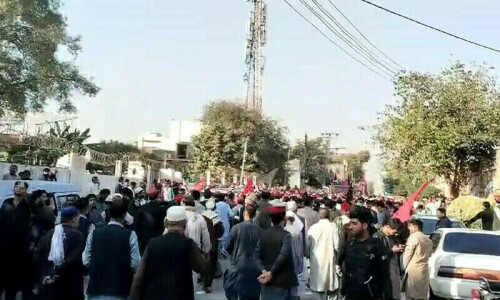Last month, the capital administration barred media from using Unmanned Aerial Vehicles (UAVs), commonly known as camera drones, for the collection of aerial footage, saying that such detailed visuals of sensitive areas could be exploited by terrorists intending to target key buildings.
But despite the ban, TV channels have been using drones to cover the joint sit-ins of the Pakistan Tehreek-i-Insaf (PTI) and Pakistan Awami Tehreek (PAT).
These camera drones were first used by the media during a PTI rally in Islamabad on May 11 this year. Shortly thereafter, intelligence and security agencies expressed alarm over the use of UAVs and declared them a risk as there was no way to distinguish a ‘friendly’ UAV from one that might possibly be used for a terrorist attack.
Security agencies’ fears are not unfounded. In September of last year, when two men with suspected links to militant groups were arrested from Khayaban-i-Kashmir, law enforcement personnel recovered four remote-controlled planes and a large quantity of explosives and ammunition from their possession.
Police suspect the men were planning to rig the plane with explosives and fly it into their intended target. Such an attack would be virtually impossible to protect against, while putting the attackers at minimal risk.
Therefore, it is not surprising that intelligence and security agencies have been quite worried in recent days, as drone cameras have been flying all over Constitution Avenue, where most of the country’s most sensitive buildings are located. But the police appear helpless when it comes to TV channels’ widespread use of the camera drones.
Clearly, the capital’s law enforcement agencies have bigger things to worry about and the administration has decided to shelve the matter until after these ongoing protests end.
The administration is also worried that these UAVs could prove dangerous to low-flying aircraft, such as helicopters, which usually use the airspace over Constitution Avenue.
Sources indicate that standard operating procedures (SOPs) around the use of UAVs have been formulated by the authorities, but they have yet to be shared with the media.
Under the new rules, no one will be allowed to fly UAVs or radio-controlled aircraft without a no-objection certificate from the competent authorities, except in spaces designated specifically for such activities.
The district administration is expected to designate areas where hobbyists can fly RC-planes after obtaining approval from Air Headquarters.
Moreover, it has been decided that no UAV should be allowed within a 10-kilometre radius of military installations or airports. UAV activity will be restricted to a vertical limit of 300 feet.
Specific radio frequencies will be allocated by the Frequency Allocation Board in consultation with the Ministry of Defence and these would be communicated to all concerned agencies for proper implementation and monitoring.
It will also be mandatory for the operators of such UAVs to communicate their flight plan in writing, along with detailed specifications of their UAVs a day in advance to all concerned authorities.
Police will be expected to carry out a physical inspection of each UAV before it is flown and such activities will be halted in case of any VIP movement in the area.
Any UAV that does not adhere strictly to these rules would be liable to be shot down.
Published in Dawn, September 8th, 2014












































